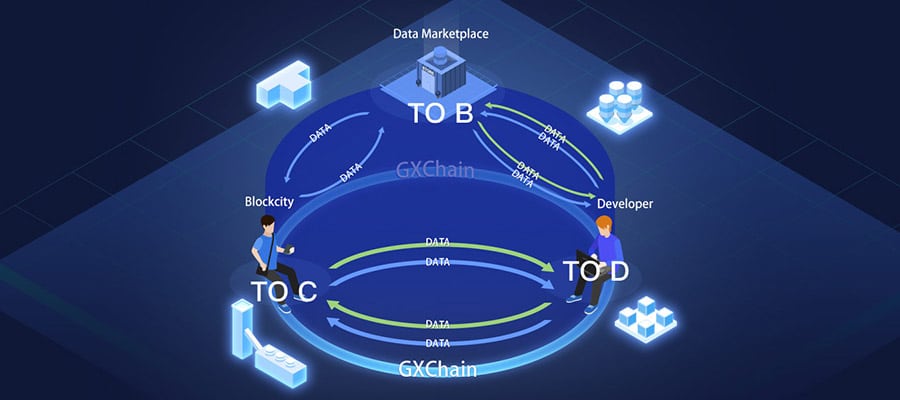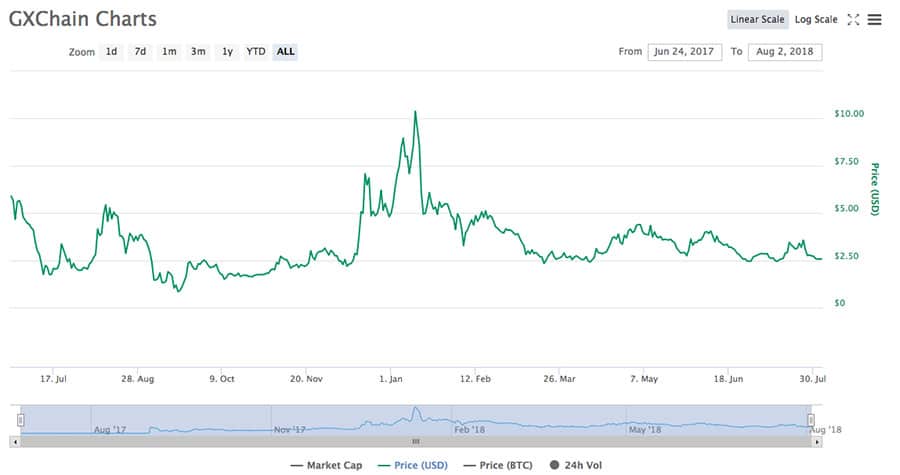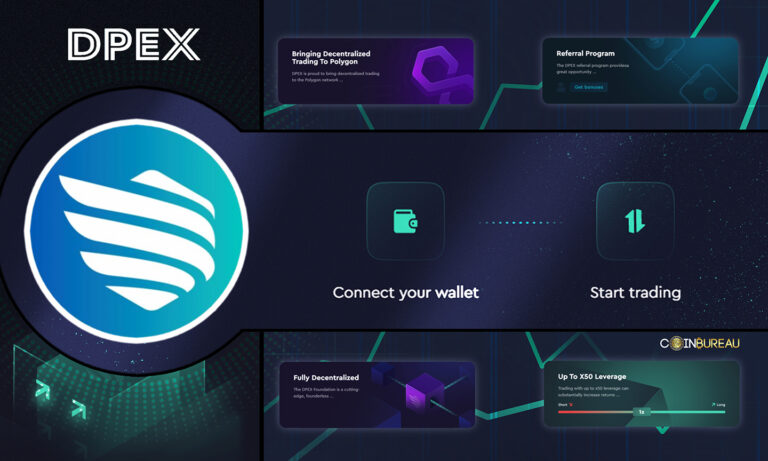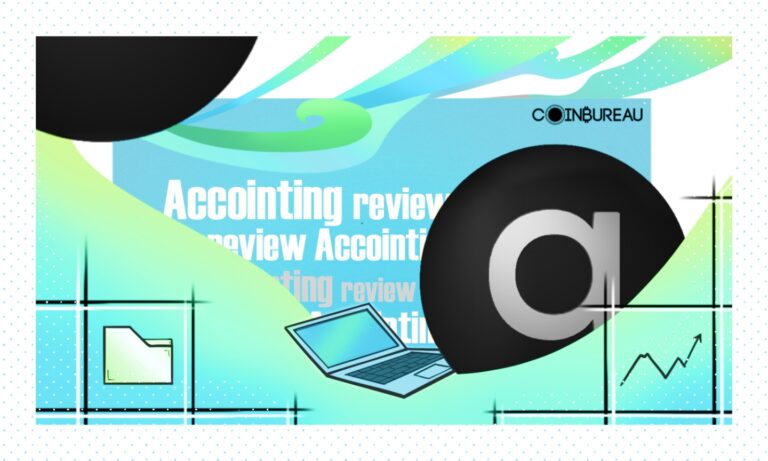There’s a coin climbing its way higher in market cap, and during the downturn in cryptocurrencies so far in 2018 it has held its own pretty well. The coin I’m talking about is GXChain’s GXS coin.
It’s an interesting public blockchain that is being created to support the storage and exchange of personal data. Unlike current applications that simply take user data and then use it to generate corporate profits, the GXChain team envisions a way for the individual to maintain control over their own data, and be able to monetize it digitally.
In this GXS Coin review, we will take an in-depth look at the project including the technology, team and token prospects. Let's jump in.
Page Contents 👉
The GXChain Vision
Many of us are well aware of how many applications and organizations currently collect and sell user data. Even if they don’t sell the data directly, they use it in ways that generate profits for the corporations, but leave the individual, the true owner of that data, uncompensated.
And up until now there has been no way for the individual to generate compensation for their own data. In fact, with personal data spread so far across so many platforms it is becoming nearly impossible to even manage your own data, or know who has possession of it.
The GXChain hopes to solve these problems by first getting user consent to collect and store personal data, and then putting that data on an indelible blockchain. Access to the data stored on the blockchain can be managed with a private key, which can be securely generated and available only to the owner of the data, giving them complete control over the distribution and usage of their own data. The GXChain team is calling this Blockcity, and I’ll discuss it in more depth later in this article.
GXChain has created a General ID or G-ID verification system that is used to verify each individual and to issue a unique G-ID that secures user data and prevents tampering with the data from other users. There will be mining through a unique Proof of Data consensus mechanism, and users can collect GXS coins as well as other cryptocurrencies.
The platform will come complete with a peer-to-peer marketplace to make it easy to sell data, trade and purchase digital and physical assets. And the GXSChain supports decentralized application development, including smart contracts and blockchain as a service (BaaS), as well as other unique services.
GXChain is striving to be the data trading network of the future, protecting user data and privacy, offering copyright protections, and usability all at the same time. Obvious real-world applications currently include consumer lending, insurance and banking, but there are many other ways that the blockchain and platform could be utilized, including for medical applications, consumer services, and even entertainment.
The GXChain Team
The CEO and founder of GXChain is Minqiang Huang, also known as Vincent, who has been involved in data exchange technologies for over 10 years. He also has experience with fintech and has been working in the blockchain space since 2012.

The GXChain Team Members
He previously held the CTO position at Hakim Information Technology and Insigma Internet, and graduated from Shandong University of Science and Technology with a bachelor’s degree in computer science, and later from Hong Kong Finance and Economics College with a Master’s in management.
The co-founder and vice-president of GXChain is Goujun Tu, also known as Andy, who has been a senior executive at three different companies, and has spent the past 21 years as a serial entrepreneur in the information security and payment fields.
GXChain Technology
There are three distinct components of the technology behind the GXChain platform. Each component is designed for a different user group, and it is being called the “CBD” model by the team, which stands for Customer, Business, Developer.
Blockcity – Customer Component
Blockcity is a mobile application on GXChain that will help users take control of and manage their personal data. It will allow for the sale or sharing of data, and will provide customers with incentives for authorizing the use of their data, and for validating their identity and information. With a strong emphasis on user privacy there is no caching of user data. Blockcity already has a population of more than 2 million verified users.
Decentralized Data Marketplace – Business Component
The decentralized data marketplace is a peer-to-peer alternative to traditional data transfer. That includes trade through third parties or underground data transmissions. This decentralized design has many advantages, including privacy protection, anonymity support, uncached data and fraud protections.

GXChain Network Overview
There are already several real-world applications for a decentralized data marketplace, including healthcare, insurance, fintech, lending, logistics, and even governments. The marketplace is already functioning and has brought in over $10 million in revenue.
GXChain – Developer Component
The GXChain blockchain has support for many different forms of development, including blockchain as a service, smart contracts, swift login, KYC and ID verifications, and support for multi-dimensional data.
With speeds of 100,000 transactions per second already, there are very few application types that would need more transactional speed. The GXChain also has support for the issuance of new assets or token types, making it similar to Ethereum.
The GXChain Network
GXShares (GXS) tokens were created as a way to power the GXChain. The team is taking an interesting approach, in that any time a user spends GXS on an application, service or feature those tokens will be burnt, reducing the supply over time. This was implemented to avoid the devaluation of the token over time.
There will be a total supply of 100,000,000 GXS tokens, and currently (August 2018) there is a circulating supply of 60,000,000 GXS tokens.
Rather than the typical Proof of Stake (PoS), where anyone can stake coins to help validate transactions, GXChain uses the Delegated Proof of Stake (DPoS) model. The DPoS model has coin holders vote for delegates (also called witnesses) who do the validation of transactions and maintenance of the blockchain. These delegates are rewarded for their efforts with more GXS coins.
In the future the GXChain team has said they will also be adding mining in Blockcity, but based on the current explanation it doesn’t look as if this mining will be supporting the blockchain. Instead it appears to be in support of users and the decentralized marketplace. This type of mining will be based on Proof of Data (PoD).
Proof of Data (PoD) is an innovative incentive mechanism, pioneered by the GXChain team. Users can earn digital assets through authorizing their data. This mechanism encourage users to authorize their information broadly and continually. One can receive more assets as more kinds of data are authorized.
GXS Price History
The GXS token traded above $5 when it was released in June 2017, but soon after it fell under $2, only to rebound briefly back above $5 in August. It quickly fell once more and traded between $1 and $2 until the November through January bull market in cryptocurrencies.
The all-time high for the GXS token was $10.38 on January 13, 2018. Since then the token has been trading in a range of $2.50 to $4.40. This range held even as most tokens were trading steadily lower throughout much of 2018, which is a promising sign for the future of the GXS token.
Purchasing GXS
First you’ll need a wallet to store your GXS, and the GXChain team has created an online wallet, desktop wallets for Mac, Windows and Linux, and mobile wallets for Android and iOS. All are available from the GXChain website.
The primary place for purchasing GXS is at the OEX.com exchange, which has nearly 90% of the trading volume in GXS. These transactions are all in Chinese Yuan (CNY). You can also purchase GXS with BTC or ETH at Huobi or the Binance exchange. It is also possible to purchase GXS with USD Tether from QBTC and Gate.io.
GXChain Partnerships
One reason to believe in the success of GXChain is the rising number of strategic partnerships it has made with various Chinese firms.

List of GXChain Partners
These include China Mobile, the state-owned telecommunications company which provides wireless service throughout mainland China; China Unicom, another state-owned telecommunications firm offering wireless service in mainland China; and China Unionpay, a payment processor for four major Chinese banks. In addition, GXChain has received investment funding from nearly a dozen different Chinese investment agencies and funds.
GXChain Roadmap
There is no official roadmap that’s been released by GXChain. That said, it has indicated its intention to continue developing the project, although it doesn’t want to be held to a specific timeline for events. It does however report on its progress on a Medium blog on a weekly basis. By looking back through these updates it’s easy to see that the team has made many impressive accomplishments already.
One of the most recent was the launch of the GXChain developer platform this past June. There has also been excitement recently over the fact that GXChain CEO and founder Vincent Huang has had several meetings with Alibaba, and has had encouraging feedback from them.
Conclusion
While it’s difficult to find information about GXChain other than on their website and Medium blog, the project itself seems quite solid. Especially if you think any significant portion of the more than 1 billion Chinese population will eventually make use of the GXChain platform. That’s a whole lot of users and personal data.
It’s also promising to see the partnerships being formed by GXChain, and the stability of the token throughout 2018, when most cryptocurrencies were falling steadily. This could be an indication that the coin will rally strongly once cryptocurrencies recover. It is also a good indication of the value investors are giving to the project and the platform.
Featured Image via GX Chain
















